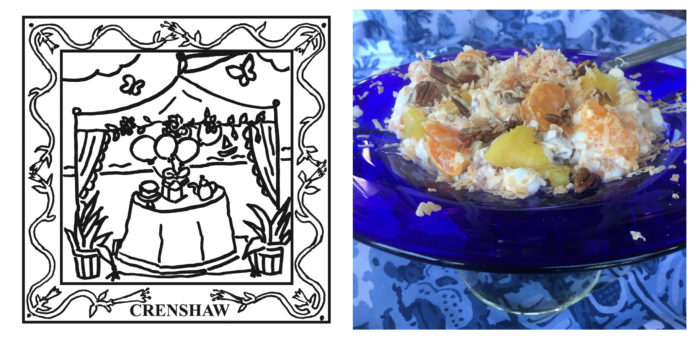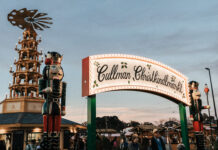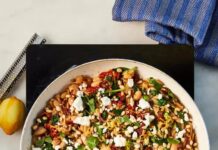
The Cullman Tribune is celebrating the Alabama Bicentennial (1819-2019) with statewide field reporting by Alabama Master Gardener/Botanical Artist Ben Johnson South. This year-long feature, “The 67-County Alabama Garden Party,” will spotlight different counties each week. Each county will get its own “quilt block,” along with a historical profile, and we’ll share a recipe specific to the area. At the end of the year, all 67 counties will be put in a book to commemorate the Bicentennial.
Crenshaw County
“Love cultivates hope; hope fertilizes resilience, and we can all be farmers of dreams.” The writer, George E. Miller, could have been speaking of the determined people who settled, farmed and eventually flourished in the deep south part of a Deep South state in Crenshaw County, Alabama.
Crenshaw County was established by the Alabama Legislature this month, November, more than 150 years ago in 1866 during the state’s Reconstruction era following the American Civil War. Cotton plantations with enslaved labor were tried here in Antebellum times, but the sandy, relatively infertile soil of this area generally made bad economics for that sort of farming.
Timbering became the major plant industry for Crenshaw County, especially after the Montgomery and Florida Railroad constructed a line through the pines in 1886. These tough, resilient folks found work in logging camps and sawmills.
Here in timber country you see broad spaces where trees have been harvested and you see thick stands of trees to be cut in future years. But you’ll also regularly see a lone, tall pine or a giant, spreading oak standing proud out in the elements without anything to support it, just deep roots in Crenshaw County. Once tough plants and people in this part of Alabama take root it’s hard to shake them loose and uproot them.
All gardeners are natural-born optimists. You’ve got to believe a seed will grow before you put it in the ground. But Crenshaw Countians have learned to be realists, too. Most of the settlers who came here were leaving areas of the Carolinas and Georgia with richer soil and more temperate climates, but people here learned to adapt to their harsher new reality.
The early Alabama settlers were also filled with gratitude for finding land to make a new start. Farming and logging families didn’t have time to complain about what they lacked. They plowed forward, chopped wood, carried water and learned to survive and thrive. Given the choice to find life bitter or find it better, the Crenshaw County settlers chose the latter.
Crenshaw County is a good place for us to explore growing plants in challenging places. Alabama is one of the finest agricultural states, but there are a number of extremes here like long, hot-as-Hades summers, hard-packed clay soil and grasslands with high winds to consider. When the growing gets tough, here are some ways the tough keep growing:
*TALK TO A LOCAL GARDENER OR FARMER- Growing plants involves a lot of learning by trial-and-error, but you can improve your chances by talking with those who have “been there, grown that.” Ask them about the soil and test yours for pH levels. If there is a Master Gardener group in your area, they are a great resource with years of tribal knowledge. Alabama has more than 30 such groups spread throughout the state.
*GO SEE THRIVING GARDENS IN YOUR AREA- You can’t easily have the same success with peaches in Ft. Payne, Alabama as you do in Clanton. And beautiful Baldwin County sea oats are a total bastard to grow in the shade. Note the plant combinations you like and the garden features that appeal to your aesthetics.
*USE NATURAL FERTILIZERS- Where possible, we want to enrich Alabama soil for the generations that will be here over the next 200 years, not poison the land. The sweet smell of gardening success includes chicken muck, home-made compost, and well-rotted cow and happy horse hockey.
*SAD PLANTS CAN BE A MOVING EXPERIENCE- If a plant is not thriving, consider giving it a new home. Even trees can be moved. “Bloom where you’re planted” is often good advice for humans, but for plants, moving them to another plot may give them a greater opportunity to succeed.
I recall being in Crenshaw County and little, purple flowers were springing up around the concrete near the courthouse in Luverne. Nature has taught plants and people in this part of Alabama that it may take a while, but seeds will grow, and with a bit of luck and nurturing, both will thrive.
Below are other positive and pleasurable PLANTS + PEOPLE things to explore in Crenshaw County including a recipe for Southern Ambrosia, a dish enjoyed in post-bellum Alabama in the late 1800s. At that time, ambrosia was a simpler dish of orange slices, coconut and sugar, which were mostly imported luxuries coming from the port at Mobile and purchased by the more well-off. Even for the more affluent, ambrosia was mostly an indulgence. Imagine a compote of ambrosia under a garden party tent like the one on our original “quilt block” for Crenshaw County.
*BRANTLEY FARMSTANDS- Allen’s Curb Market, Highway 331; Papa’s Place, Main Street; Bailey’s Produce, Main Street
*CRENSHAW COUNTY FARMERS MARKET- 88 E. First St., Luverne Methodist Church, Luverne, AL 36049; Mondays 3-6 p.m., June 3-Aug. 12
*CRENSHAW COUNTY PLANT ADVICE/EDUCATION- Alabama Cooperative Extension System local office at 29 S. Glenwood Ave. #201, Luverne, AL 36049, 334-335-6312
*CRENSHAW COUNTY EATERIES SERVING LOCALLY GROWN- Chicken Shack (Luverne), It Don’t Matter Café (Highland Home), Southern Foods (Brantley), Tater’s (Luverne)
*CRENSHAW COUNTY PLANT RETAILERS- Countryside Gardens (Rutledge), Carl Massey (Highland Home)
*BEST VIEW FOR A LANDSCAPE PHOTOGRAPHER/PAINTER- Crenshaw County Public Fishing Lake, 1075 County Lake Road, Luverne, AL 36049, 334-335-3103 or 334-403-0212
*INTERESTING PLANT TOURISM SITES- South Ridge Winery (Patsburg)
*CRENSHAW COUNTY PEAS- West Farms (Brantley), Bailey’s Produce (Brantley)
*CRENSHAW COUNTY FOOD FESTIVALS- Luverne Shriner’s Annual Peanut Boil; William Baker Glenwood Annual Festival at the Well
Y’ALL COME to Crenshaw County on your 67-County, Alabama Garden Party tour! Arrive alive and ye shall thrive.
Crenshaw County Southern Ambrosia for the Ultimate Garden Party or Holiday Celebration
The first time I was introduced to my future mother-in-law she was making ambrosia for a holiday gathering. It was not something I had growing up, but it quickly became one of my favorite and most anticipated holiday foods. I’ve read recently that it is also a favorite holiday dish of Alabama writer and actress, Fanny Flagg. Its fresh citrus flavors blend perfectly with sweet cream, coconut and pecans. A traditional version calls for clementines or navel oranges, but this one was made using southern-grown satsumas, which are reported to be the sweetest of all of the orange varieties. Ambrosia holds its own as a side dish to a savory meal or on the desert table.
Ingredients:
- 2 cups peeled satsuma or clementine orange segments, sectioned and white membrane removed
- 1 cup peeled grapefruit segments, sectioned and white membrane removed
- 1 cup fresh pineapple, cut into bite-sized chunks
- 1 cup sweetened coconut flakes
- 1/2 cup toasted pecan pieces (see Lowndes County recipe)
- 1/2 cup mini marshmallows (optional)
- 1 cup orange flavored, fresh whipped cream:
- One small carton of heavy whipping cream, 1/8 cup sugar and 1/2 tsp. of orange extract
- 1/4 cup sour cream
Instructions:
- Toast about half of the coconut and leave the other half moist. To toast, preheat oven to 325F and place coconut into the oven on a parchment paper-lined pan. Check and stir after 3 minutes and then again about every minute for about 3 more minutes, taking care it doesn’t burn. Reserve the toasted coconut and some of the pecans for garnish.
- Prepare whipped cream: Chill a large bowl and beaters from a hand or stand mixer. Place the whipping cream into the chilled bowl and start beating at medium speed until cream starts to thicken. Add the sugar and orange extract gradually. Once incorporated, taste, adjust and then beat on high for another 2-3 minutes until soft peaks form. Don’t overbeat or you will end up with a butter-like consistency.
- Mix up the ambrosia: You will likely have more whipped cream than you need, so add it last. (The extra should keep for a day or so in the refrigerator, so you’ll have enough to garnish a pie or some other wonderful holiday dish.) First, fold together the prepped fruits, moist coconut, marshmallows and most of the pecans with the sour cream. Fold in the whipped cream, a little at a time, until you get your desired consistency. Chill well, at least a few hours, before garnishing with reserved toasted coconut and pecans and enjoy!
Also, check out Alabama Bicentennial: 200 ways to save Alabama for the next 200 years.
Copyright 2019 Humble Roots, LLC. All Rights Reserved.






























